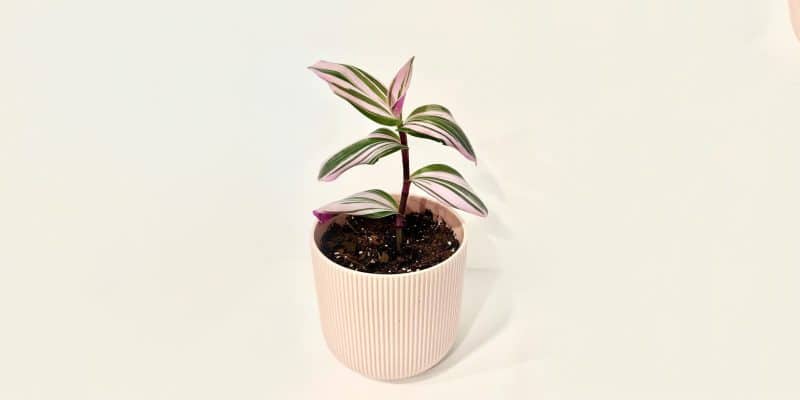Have you ever laid eyes on a Tradescantia Nanouk (aka the vibrant, colorful gem of the plant world) and thought, “Wow, I need that in my life”?
Well, you’re in the right place, because today, we’re diving into everything there is to know about this jaw-dropping beauty.
Picture this: a slow-growing plant with captivating hues of light green and pink gracefully adorning its leaves and stems.
You see, what makes the Nanouk so special is not just its mesmerizing appearance, but also its versatility – it can thrive both indoors and outdoors!
So, are you ready to learn all the ins and outs of caring for this stunner? From propagation and lighting to keeping those common plant woes at bay, we’ve got you covered!
In no time, you’ll be your own Tradescantia Nanouk care expert, making your friends green with envy!
Table of Contents
Tradescantia Nanouk care
History, Habitat, and Characteristics
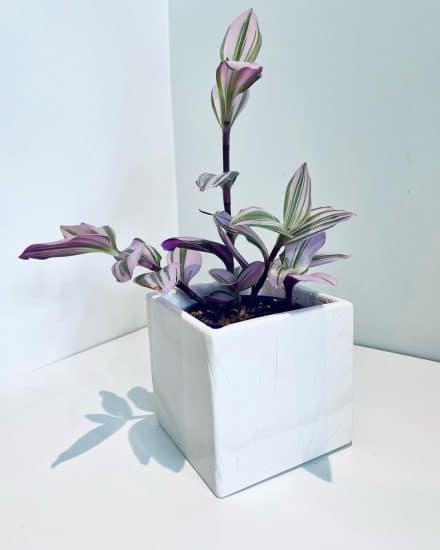
While we know Tradescantia Nanouk (also known as Fantasy Venice or tricolor spiderwort) originated in a Dutch laboratory, there’s some debate about which species it actually belongs to.
We can trace other Tradescantia plants to a South American origin, but this plant is a little trickier. Tradescantia fluminensis and Tradescantia albiflora were previously thought to be separate species, but they’ve since both been combined, and it’s still subject to some debate among botanists.
But no matter the origin, the result is a stunning, slow-growing plant that’ll jazz up any indoor garden.
Nanouk’s leaves are a mix of light green and pink variegation that prance along its stems. If you’re not careful with lighting, though, the leaves might lose that lovely pink hue and turn green.
(Do your Nanouk a favor and make sure it enjoys plenty of indirect sunlight.)
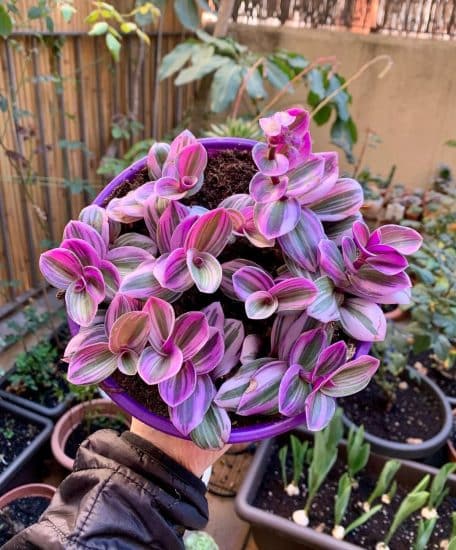
Tradescantia Nanouk isn’t just an indoor superstar, but it can also flourish as an outdoor plant! Talk about versatility, right?
Fun fact: Tradescantia Nanouk may be a fresh face in the plant world, but its botanical family goes way back. The genus Tradescantia is named after John Tradescant the Elder, a 17th-century English botanist and gardener. He introduced heaps of plants to England from his travels, and now we have this stunning creation!
Now let’s get right into Tradescantia Nanouk care, and we’ll start with…
Light
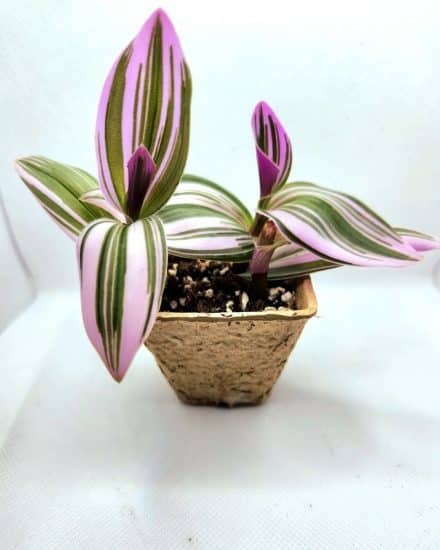
You know that friend who loves bright, sunny spots but can still hang out in the shade when needed? That’s your Tradescantia Nanouk!
How can you make sure your plant gets the perfect amount of light? First, think about where to place it. Bright indirect light with a touch of partial direct sunlight is your best bet — picture something like an east-facing window or an area with filtered sunlight.
What happens if it doesn’t get enough light, though? Well, you might notice the Tradescantia Nanouk turning green as the leaves lose their beautiful pink hue (and nobody wants that!).
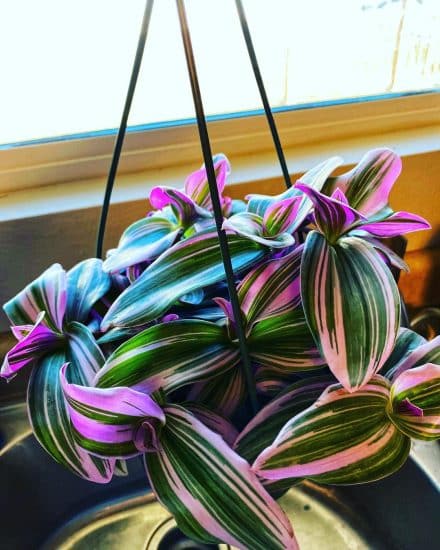
Keep an eye out for these signs to make sure your Nanouk plant gets enough light:
- Is the plant losing its pink color? It might be craving more bright indirect light.
- Are leaves looking faded or developing brown spots? Too much direct light.
- No natural light in your space? Try using a grow light, or even consider bringing it outside a bit.
Give your plant a little spin every couple of weeks too. Rotating your Tradescantia Nanouk promotes even growth and balanced exposure to light. Plus, it prevents the plant from reaching too far toward the light source and becoming lopsided.
Water
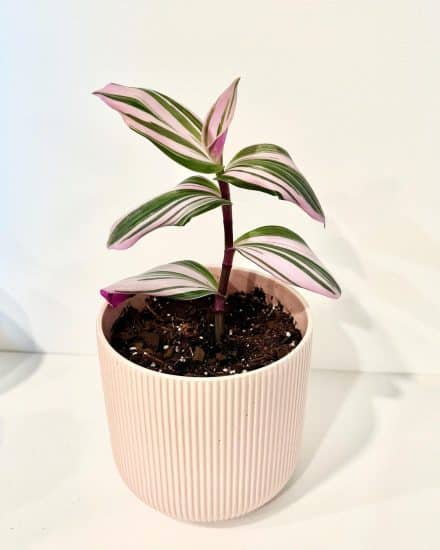
Tradescantia Nanouk can be a bit sensitive when it comes to watering.
Before you even think about watering your Tradescantia Nanouk plant, give those leaves a gentle squeeze. If they’re firm, your plant is saying “Thanks, I’m good!”
But if they’re getting a bit soft, it might be time for a drink. Make sure to let the soil dry out completely between waterings, but keep the soil moist overall to ensure proper care. Don’t let it turn into a desert in there, or your Nanouk plant’s leaves might start to crisp up around the edges.
Not enough water can cause leaves to droop, curl up, or even drop off altogether. If that happens, give your thirsty Tradescantia Nanouk some more water — and maybe an apology for neglecting it. Keep a closer eye on its hydration, and don’t forget to remove any sad, shriveled leaves to keep pests like spider mites at bay.
Too much water, on the other hand, can lead to yellowing leaves, mushy stems, or even a funky odor coming from the potting mix. Remember, Tradescantia Nanouk plants can be drama queens when it comes to overwatering, so you’ll want to let the soil dry out before you water again.
Better to be a little stingy with the water than to leave your plant swimming in it (and risking rot).
Temperature and Humidity
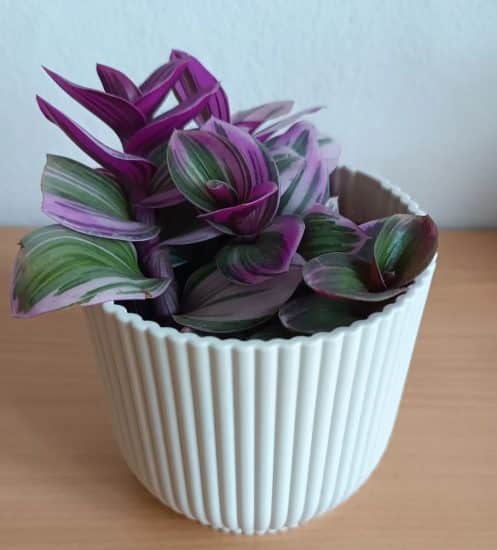
Tradescantia Nanouk does well in normal household temperatures, but it’s still important to keep a few guidelines in mind.
Tradescantia Nanouk plants appreciate consistent, moderate temperatures. Aim for a range of 65-80 degrees Fahrenheit (18-27 degrees Celsius) for optimal growth. As a tropical plant native to South America, temperatures below 50°F (10°C) can harm it.
Keep your Nanouk plant away from cold drafts, air conditioning vents, and windows regularly opened during the winter.
When it comes to humidity, Tradescantia Nanouk can adapt to typical indoor conditions. However, aiming for a humidity level of around 40-60% will help it flourish. If you notice the leaves start to turn brown or crispy at the edges, this could indicate that the humidity level is too low.
On the other hand, yellowing leaves or rot might mean it’s getting too much humidity.
There are a few ways to increase the humidity around your plant without misting it directly, as the moisture can damage its leaves. Grouping plants together can naturally increase humidity, as they release moisture through a process called transpiration.
Another option is to place your Nanouk plant on a pebble tray filled with water, which increases the surrounding humidity as the water evaporates. If you live in a particularly dry climate, using a humidifier can also help maintain the right amount of humidity for your Tradescantia Nanouk.
Soil and planting
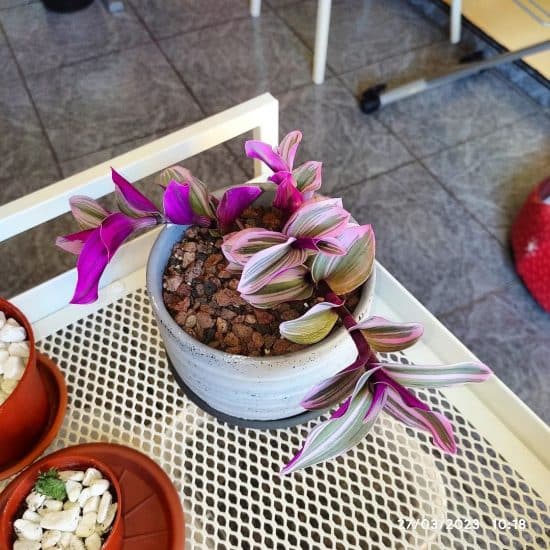
Tradescantia Nanouk thrives in well-draining, nutrient-rich soil. Achieving good drainage is crucial for a happy and healthy Tradescantia albiflora ‘Nanouk’ plant. A mix of potting soil, peat moss, and perlite can provide a great soil mixture for this houseplant.
For instance, consider using:
- 50% potting soil
- 30% peat moss for moisture retention
- 20% perlite for aeration and improved drainage
Tradescantia Nanouk has a relatively slow growth rate and doesn’t require frequent repotting. However, when it’s time to move to a larger container, be sure to choose one with drainage holes and only slightly larger than the previous pot.
Fertilizer
Tradescantia Nanouk benefits from regular, light fertilization. Use a standard houseplant fertilizer, diluted to half the recommended strength, every four weeks during the growing season (spring and summer).
Overfertilization can lead to symptoms such as leaf burn, yellowing foliage, and slow growth. If you suspect you’re using too much fertilizer, flush the soil with clean water to remove excess nutrients. Be sure to reduce the frequency and strength of your fertilizer applications in the future to prevent additional problems.
Propagation Guide
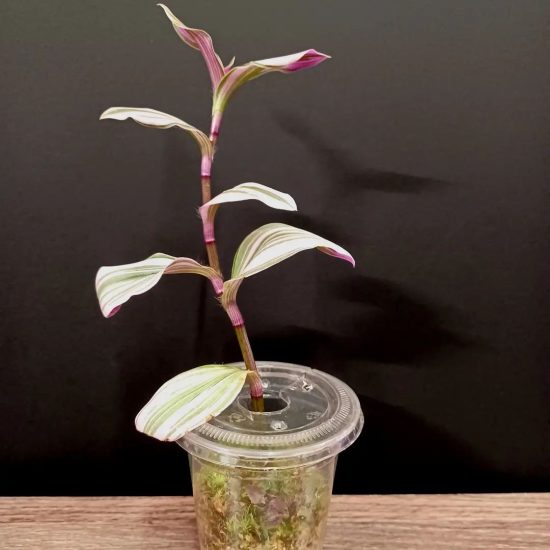
Want to spread the joy of your beautiful Tradescantia Nanouk and share it with friends, or just add more to your collection?
Tradescantia Nanouk propagation is super easy with stem cuttings, and we’re here to walk you through it.
- First things first, let’s choose a healthy Tradescantia Nanouk to grab a cutting from. Try to find one that’s just showing off its aerial roots – a sign it’s more than ready for this process. With clean and sterilized scissors, snip off a 4-6 inch segment that has at least a couple of happy-looking leaves.
- Gently remove any extra leaves from the lower part of the stem, leaving only two to three leaves at the top. This way, your cutting can focus its energy on growing those brand-new roots instead of maintaining the old leaves.
- You can root your cutting in soil or water – the choice is yours. Water propagation is pretty cool because you can actually see the roots growing, while soil propagation can potentially speed up the process.
- If you’ve chosen the water route, find a small container and fill it with filtered or distilled water. Pop the cutting right in there, making sure none of the leaves take a dive. Change the water every 2-3 days to keep it fresh.
- If you’re more of a soil fan, grab a pot with fresh, well-draining potting mix that includes some orchid bark. Create a hole just deep enough to bury the nodes (where you removed the leaves), place your cutting in it, and gently pat the soil around the stem so it stays upright.
Tradescantia Nanouk cuttings usually root pretty quickly when given bright indirect sunlight and a humid environment, but keep an eye on them. Once the roots are about 1-2 inches long, it’s time to reward your cutting with its very own pot filled with regular potting mix.
(They grow up so quickly.)
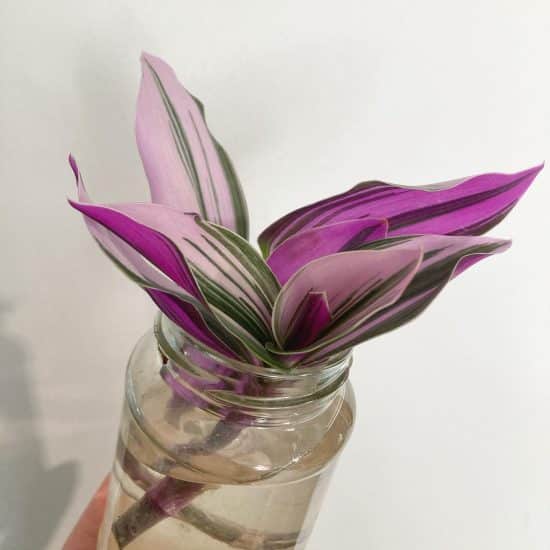
Keep in mind that Tradescantia might be a little more stubborn than other plants when it comes to propagation — around one-third of the time, it usually fails. If at first, you don’t succeed, try, try, and try again! Or better yet, try a few at once.
Propagate Tradescantia Nanouk and enjoy watching your new plants flourish, hopefully with plenty of bright light.
Common issues
Tradescantia Nanouk care is usually pretty easy, but even the easiest indoor plants still suffer from an issue now or then. Let’s get into the main problems you might encounter and how to fix them.
Crispy Leaf Edges
You know those dry, crunchy edges on your plant’s leaves that seem to curl inwards? Yeah, that’s probably because your gorgeous Nanouk isn’t getting enough water, or it’s been too dry for too long. It’s like the plant is asking for a refreshing drink…
So, here’s what you do: make sure to keep the soil consistently moist (but not too soggy!). Check the top inch of the soil before giving your plant a drink – if it’s dry, it’s time to water. Want to show your plant some extra love? Boost that humidity.
Leaves Reverting
Now, let’s talk about those leaves turning green and losing their amazing colors. It’s like your plant is waving a little green flag, letting you know it’s not getting enough light to show off its true beauty.
This is your cue to find a spot with more bright indirect sunlight for your Nanouk (just remember, direct light is a no-no – we don’t want to burn those pretty leaves).
It might take a little trial and error, but once you find the sweet spot, your plant’s vibrant colors should make a comeback in the new leaves.
Pests and diseases
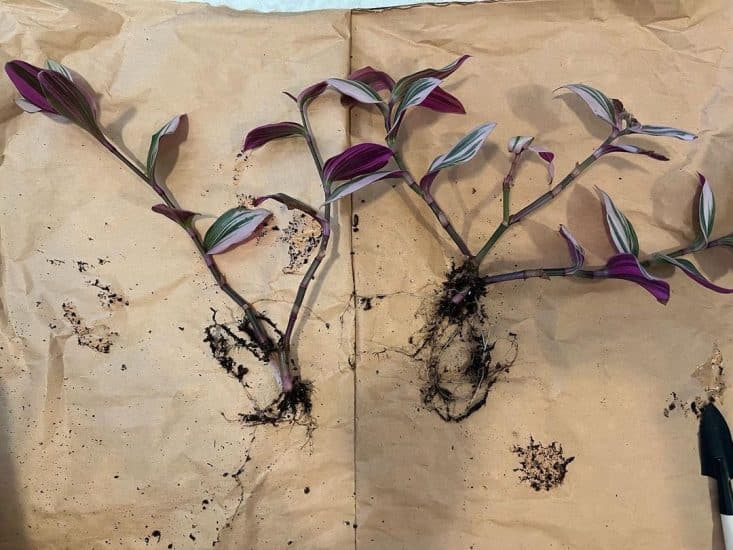
Your Tradescantia Nanouk plant can suffer from a few issues with pests and diseases, so let’s get right into what we see most frequently with these plants.
Root rot
Root rot usually happens when we love our plants too much and give them too much water. You’ll notice the leaves wilting, and there might be an unpleasant smell coming from the soil (yikes!). When you take the plant out of its pot, the roots will be all mushy, slimy, and well… gross.
But hey, no need to panic! Here’s what you can do to save your plant:
- Gently remove your plant from its pot and delicately cut away those sad, rotten roots with clean, sterilized scissors (don’t forget to sterilize them afterward, too).
- Repot your plant in fresh, well-draining soil. Opt for a mix that contains perlite, pumice, or LECA to let your plant’s roots breathe and drain excess water easily. Make sure you’re using a pot with a proper drainage hole to prevent root rot in the future.
- Let the soil dry out a bit before you water it again.
Pests
Now, let’s talk about another issue our indoor houseplants sometimes face: common pests like spider mites or mealybugs.
Spider mites might be hard to spot, but if you see tiny webs on the leaves or stems, that’s a dead giveaway. Mealybugs, on the other hand, look like little cotton balls chilling on your plant.
Found some unwelcome guests? Here’s what you should do:
- Remove any visible pests using a damp cloth or a soft spray of water (you don’t want to hurt your plant in the process!).
- Apply neem oil to the affected areas, paying special attention to underneath the leaves and even the top of the soil
- Keep an eye on your plant for a few weeks to ensure those pesky pests, including all the spider mites, have packed their bags. This will also help in preventing the growth of fungus gnats. Reapply a few times, every few weeks.
Conclusion
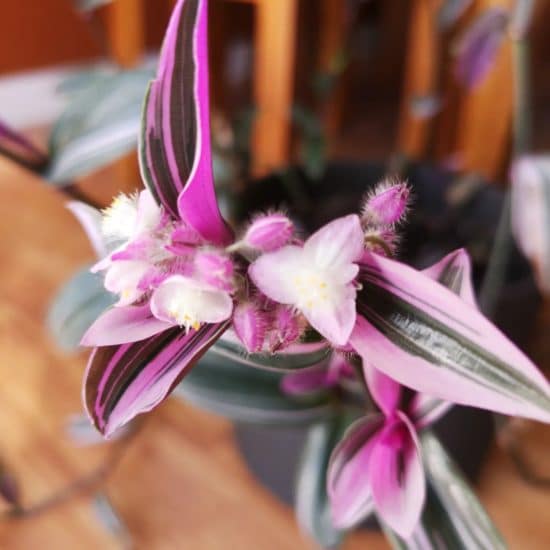
That’s a wrap for our Tradescantia Nanouk care guide! Now you’re all set to grow and maintain this vibrant, eye-catching plant with ease.
Tradescantia Nanouk care summary:
- Provide your Nanouk with bright, indirect light and a touch of partial direct sunlight to keep its stunning colors.
- Be mindful of your watering habits, allowing the soil to dry out between waterings – not too wet or too dry.
- Maintain a consistent, moderate temperature of 65-80°F (18-27°C) and aim for humidity levels between 40-60%.
- Use well-draining, nutrient-rich soil with a slightly acidic to neutral pH level, and fertilize lightly during the growing season.
- Propagate your Nanouk through stem cuttings and share the love with friends or expand your own collection!
We hope this guide has you feeling confident and ready to give your Tradescantia Nanouk the best possible care. If you have any questions or need further guidance, feel free to drop us a line.
And if you found this guide helpful, why not share it with a fellow plant enthusiast?
Happy gardening, and take care!
FAQ
Does Tradescantia Nanouk need misting?
Your Tradescantia Nanouk doesn’t really need misting, and in fact, direct moisture on its leaves could end up damaging them. Instead of misting, focus on maintaining a humidity level of around 40-60% for your Nanouk.
You can increase humidity by grouping plants together, placing your plant on a tray of pebbles and water, or using a humidifier. To keep those lovely leaves clean, you can gently wipe them with a moist cloth to remove dust and keep them healthy; this is great for discouraging pests, too.
How do I make my Nanouk fuller?
Here’s how you can help your Tradescantia Nanouk grow into a fuller, bushier beauty:
- Proper lighting: Make sure your Nanouk gets enough bright indirect sunlight. This will encourage the plant to grow bushier rather than reaching out for more light.
- Rotate your plant: Giving your plant a little spin every couple of weeks promotes even growth and balanced exposure to light, helping it grow fuller and preventing it from becoming lopsided.
- Pruning: Don’t be afraid to give your Nanouk a trim! Prune back long, leggy stems to encourage the plant to produce new, bushier growth.
- Propagate: Tradescantia Nanouk is easy to propagate — you can take stem cuttings and plant them in the same pot with your current plant. This will make the pot fuller and give your Nanouk a more bushy appearance.
Is Tradescantia Nanouk toxic?
Tradescantia Nanouk is considered toxic to pets and humans. The sap contained in the leaves and stems can cause irritation if ingested or if it comes into contact with the skin. So, be sure to keep your lovely Nanouk away from curious pets and little ones to avoid any mishaps.

